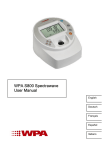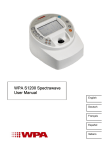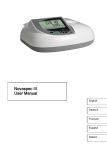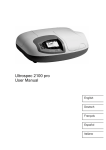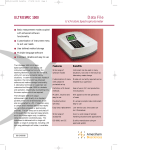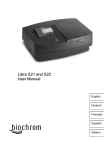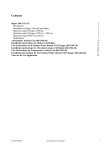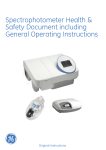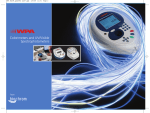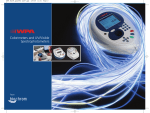Download Ultrospec1100and 500 Eng - GE Healthcare Life Sciences
Transcript
Biochrom Ltd Certificate No. 890333 Declaration of Conformity This is to certify that the Ultrospec 1100 pro UV/Vis Spectrophotometer Part number 80-2112-00 / 01 / 02 / 03 Serial number 79000 onwards and the Ultrospec 500 pro Visible only Spectrophotometer Part number 80-2112-50 / 51 / 52 / 53 Serial number 79000 onwards manufactured by Biochrom Ltd. conform to the requirements of the following Directives-: 73/23/EEC & 89/336/EEC Standards to which conformity is declared • EN 61 010-1: 1993 Safety requirements for electrical equipment for measurement, control and laboratory use. • EN 61326-2.3: 1998 Electromagnetic compatibility - Generic emission standard part 1. Electrical equipment for measurement, control and laboratory use. • EN 61000-4-6: 1992 Electromagnetic compatibility - Generic immunity standard part 1. Residential, commercial and light industry. Dated: 2nd April 2002 Signed: David Parr Managing Director Biochrom Ltd Postal address Telephone Telefax Biochrom Ltd 22 Cambridge Science Park Milton Road Cambridge CB4 0FJ England +44 1223 423723 +44 1223 420164 e mail: [email protected] website: http://www.biochrom.co.uk Registered in England No: 974213 Registered Office: 22 Cambridge Science Park, Milton Road, Cambridge CB4 0FJ, England. CONTENTS Unpacking, Positioning and Installation Essential Safety Notes OPERATION Introduction Using the Instrument Display and Keypad Customisation of the instrument menu Basic Modes of Use Enhanced Modes of Use Method storage, recall and deletion SET-UP Menu customisation, access code and methods Lamp settings Display contrast and instrument output 1 2 3 3 4 5 6 10 18 19 19 20 20 ERROR MESSAGES 21 OUTPUT OF RESULTS 22 Use with parallel printer Use with chart recorder Use with PC 22 22 22 ACCESSORIES Lamps, consumables and other items MAINTENANCE After Sales Support Lamp Replacement Deuterium Lamp Warranty (Ultrospec 1100 pro) Fuse replacement Cleaning and general care of the instrument APPENDIX Equation entry using the Multi Wavelength mode SPECIFICATION Warranty 23 23 24 24 24 26 26 26 27 27 28 30 Unpacking, Positioning and Installation • Inspect the instrument for any signs of damage caused in transit. If any damage is discovered, inform your supplier immediately. Check the position of the metal lamp bracket inside the lamp access area. • Ensure your proposed installation site conforms to the environmental conditions for safe operation: Indoor use only Temperature 10°C to 40°C Maximum relative humidity of 80 % up to 31°C decreasing linearly to 50 % at 40°C • The instrument must be placed on a hard, flat bench or table that can take its weight (6 kg) such that air is allowed to circulate freely around the instrument. • Ensure that the cooling fan inlets and outlets are not obstructed; position at least 2 inches from the wall. • This equipment must be connected to the power supply with the power cord supplied and MUST BE EARTHED (GROUNDED). It can be used on 90 - 240V supplies. • Switch on the instrument. Prior to calibration, the display asks you to check that the cell compartment is clear. The purpose of this is to indicate the use of the function soft keys, and how they are associated with the options presented at the bottom of the display; F2 represents OK in this instance (this display can be disabled in Set-up if required). The calibration stages are indicated in sequence (- for checking, ü for OK, û for Fail). • At switch on the language of the instrument can be changed if required. The relevant key should be held down while the instrument is switched on. The following numbers correspond to the languages available: 0 English 1 German 2 French 3 Spanish 4 Italian If this equipment is used in a manner not specified or in environmental conditions not appropriate for safe operation, the protection provided by the equipment may be impaired and instrument warranty withdrawn. ________________________________________________________________ ___ Issue 02 - 08/2002 English 1 Essential Safety Notes There are a number of warning labels and symbols on your instrument. These are there to inform you where potential danger exists or particular caution is required. Before commencing installation, please take time to familiarise yourself with these symbols and their meaning. Caution (refer to accompanying documents). Background colour yellow, symbol and outline black. WARNING UV RADIATION HOT WARNING UV RADIATION IS HARMFUL TO YOUR EYES If power is restored with this cover removed, eye protection must be worn ________________________________________________________________ ___ 2 English Issue 02 – 08/2002 OPERATION Introduction Your spectrophotometer is a simple-to-use, microprocessor-controlled instrument. In addition to the basic modes of operation, the instrument has enhanced software and method storage functionality. A laboratory technician or supervisor can customise the spectrophotometer for students and operators by disabling menu options that are not required. Your spectrophotometer: • has basic modes of operation ♦ ♦ • measurement of absorbance, % transmission and concentration values, output of simple kinetics assays and wavelength scans to display. has enhanced modes of operation ♦ ♦ ♦ ♦ the facility to enter a multi point standard curve in memory the application of a factor to an absorbance change over a specified time interval for an enzymatic determination (reaction rate) the use of absorbance values in a multi wavelength equation specified by you, with direct output of results, saving post run calculation the ability to quantify nucleic acids using stored equations and factors (Ultrospec 1100 pro only) • stores up to 9 user defined methods • can have any combination of the above, including methods, enabled so as to customise the instrument for your own specific laboratory needs • can be connected to a standard Centronics parallel printer for output of results • can be linked via a serial interface adapter lead to a PC for download of results to spreadsheet, and subsequent inclusion in a laboratory information management system (LIMS) A range of accessories further enhances the capability of the instrument. ________________________________________________________________ ___ Issue 02 - 08/2002 English 3 Using the Instrument Display and Keypad The back-lit liquid crystal display has large characters which are easily visible, useful if a group of students are gathered around for a demonstration, for example. The keypad is a spill proof membrane that is very hard wearing. The instrument is easy to use, with function select / entry soft keys on the keypad (F1, F2 and F3) being situated directly below the corresponding option on the display; these keys are used in conjunction with on-screen prompts. On the absorbance home page, for example, concise help text is available at the push of the F1 key, whereas Menu and Set-up are accessed by F2 and F3, respectively. On other displays, the purpose of the keys changes, but this is clearly indicated; for example, F3 acts as the “accept” option on parameter entry displays and next page (if further options exist) in the Menu and Set-up displays. Pressing the red stop key acts as an escape mechanism in most situations. ________________________________________________________________ ___ 4 English Issue 02 – 08/2002 Press: ← to clear incorrect user entries from the display. λ to enter the wavelength at which the instrument is to be used. to set reference of absorbance to 0.000AU on a reference solution at the current wavelength in the mode selected. Where it is standard operating procedure, the user is prompted to insert a cell containing a reference into the cell holder. to start making measurements or print results. to stop making measurements or return to the initial parameter screen within the current operating mode. • to print result Esc to stop an experiment (time intervals and wavescan only) OK To go to the absorbance page after calibration or from set-up. Customisation of the instrument menu Customisation of the menu to suit laboratory needs is an important benefit of the instrument. This facility is password protected so that only authorised personnel are able to set up or change the instrument. • • • In a teaching laboratory, a laboratory technician might choose to have only the modes of Absorbance, Factor Concentration, Time Intervals and Scan available. In the QC lab, the supervisor may choose to have Absorbance, Standard Concentration, Multi-point Standard Curve entry and Reaction Rate. Similarly, a production line might have Absorbance and two methods as the instrument start up; in this case, the methods could both be multi wavelength equations involving factors, and set up in the analytical laboratory for use by operators. To customise the instrument, refer to Set-up > Menu for further details. ________________________________________________________________ ___ Issue 02 - 08/2002 English 5 Basic Modes of Use Absorbance Absorbance mode is default after power on and calibration. It makes simple absorbance measurements on samples, measuring the amount of light that has passed through a sample relative to a blank (this can be air). The procedure is as follows: Press λ key and enter appropriate wavelength Insert reference, press key. This reference value is used for subsequent samples until changed. Insert samples as required and record the absorbance. % Transmission Transmission mode measures the amount of light that has passed through a sample relative to a blank (this can be air), but displays the result as a percentage. The procedure is as follows: Press λ key and enter appropriate wavelength Insert reference, press key This reference value is used for subsequent samples until changed. Insert samples as required and record the transmittance. Concentration Factor concentration mode is used when a conversion factor is known, and is required to convert the absorbance measurement for a sample at a specific wavelength into a concentration, by a simple multiplication of absorbance x factor. The procedure is as follows: Enter appropriate wavelength Enter known factor (range 0.01-99999) Insert reference, press key This reference value is used for subsequent samples until changed. If you wish to save as a method, go to set-up (F3) ________________________________________________________________ ___ 6 English Issue 02 – 08/2002 Insert samples as required and record the concentrations. ________________________________________________________________ ___ Issue 02 - 08/2002 English 7 Time Intervals Simple kinetics studies for teaching laboratory experiments can be readily performed. The wavelength of interest is entered together with the time interval at which absorbances are to be read; the option of having a reference reading prior to the run is available. A count down facility indicates the time remaining until the next measurement. To end an experiment, the stop key is pressed. The procedure is as follows: Enter appropriate wavelength Enter time unit (seconds or minutes) Enter end time ( 10,000) Enter the time interval for each reading (range 1-60 seconds). A minimum of 10 data points are required, and the time interval for this is calculated. If you require a reference reading press F3 (if not, press F2) Insert reference, press key This reference value is used for subsequent samples until changed. If you wish to save as a method, go to set-up (F3) Insert sample, press key Press . to print graphic Press key when the experiment is complete ________________________________________________________________ ___ 8 English Issue 02 – 08/2002 Wavescan An absorption spectrum can be obtained from your instrument; this enables simple identification of peak height and position. A reference scan has to be obtained first since there is no stored baseline. The procedure is as follows: Enter start wavelength Enter end wavelength (nearest 10, 20, 50 or 100 nm to start wavelength) Insert reference, press key This reference value is used for subsequent samples until changed. If you wish to save as a method, go to set-up (F3) Insert sample, press key (repeat as necessary) Press . to print graphic Use the 3 (F1) and 4 (F3) keys to move the cursor in order to identify peak height and position. To zoom in on a region, press F2 followed by the start and end wavelengths (the instrument will zoom to the nearest 10, 20, 50 or 100 nm). ________________________________________________________________ ___ Issue 02 - 08/2002 English 9 Enhanced Modes of Use Standard Concentration Standard Concentration mode is used when a sample of known concentration is available; by measuring the absorbance of this at a specific wavelength, the conversion factor is calculated (see above), and this can be applied to other samples of unknown concentration. This is equivalent to a one point calibration, and assumes that a sample of zero concentration has zero absorbance. The procedure is as follows: Enter appropriate wavelength Enter concentration of known standard Insert reference, press key This reference value is used for subsequent samples until changed. Insert standard, press The absorbance value is displayed; press F2. If you wish to save as a method, go to set-up (F3) Insert samples as required and record the concentrations relative to the standard. If recalling as a method, set reference before measuring samples. ________________________________________________________________ ___ 10 English Issue 02 – 08/2002 Standard Curve The construction of a multi point calibration curve from standards of known concentration in order to quantify unknown samples is a fundamental use of a spectrophotometer; this instrument has the advantage of being able to store this curve as a method. The procedure to construct the standard curve is as follows: Select whether cubic spline or linear regression fit of the data points is required Enter appropriate wavelength Input the number of standards to be used: For cubic spline fit, a minimum of 4 standards is required; maximum is 10. For linear regression, a minimum of 3 data points is required (if 1 is entered, the mode reverts to standard concentration); maximum is 10. Enter the concentrations of the standards in increasing value *. Insert reference, press key This reference value is used for subsequent samples until changed. Insert standard 1 of known concentration, press The absorbance is displayed; press F2 to proceed to next standard. Repeat as necessary for all standards Press . to print graphic The display shows - - - -, signifying that the standard curve has been defined, and that samples can now be measured. If you wish to save as a method, go to set-up (F3) Insert samples as required and record the concentrations relative to the standard curve. Any sample absorbance / concentration which is outside the limits defined by the standards used is displayed as - - - - . If recalling as a method, set reference before measuring samples. The display continues to show - - - - after the set reference. To recall stored method parameters only, for example in protein assays where freshly prepared standards are frequently used with new samples, press STOP after method recall. Press enter to move through the stored method parameters, and measure the absorbances of the fresh standards in the usual way; these new values are used in the standard curve. - To include a zero concentration standard, include this in the number of standards to be entered and enter 0.00 for concentration; use a blank when ________________________________________________________________ ___ Issue 02 - 08/2002 English 11 required to enter standard 1. If using duplicates, enter the same concentration twice; 2 duplicates of 3 different concentration equals 6 standards. ________________________________________________________________ ___ 12 English Issue 02 – 08/2002 Reaction Rate Reagent test kits are routinely used for the enzymatic determination of compounds in food, beverage and clinical laboratories by measuring NAD / NADH conversion at 340 nm. The change in absorbance over a specified time period can be used to provide useful information when an appropriate factor, defined in the reagent kit protocol, is applied. Note that reaction rate and enzyme activity can be calculated if the factor used takes account of the absorbance difference per unit time, as opposed to the absorbance difference per se. The correlation (quality of line fit) is calculated from 10 equally spaced absorbance / time points during the course of the experiment. The procedure is as follows: Enter appropriate wavelength Enter time unit (seconds or minutes) Enter delay time, if applicable (0 600) Enter end time ( 10,000) Enter factor (range 0.01-99999) If you require a reference reading press F3 (if not, press F2) Insert reference, press key This reference value is used for subsequent samples until changed. If you wish to save as a method, go to set-up (F3) Insert sample, press key. The display indicates the change in absorbance for each of the calculated time intervals as the assay proceeds. The result (total change in absorbance over the reaction time multiplied by the factor) is displayed; press F2 to display the correlation (a correlation of > 0.95 is expected if the assay was carried out over a linear section). If recalling as a method, set reference before measuring samples. ________________________________________________________________ ___ Issue 02 - 08/2002 English 13 Multi Wavelength Equation Entry The measurement of Absorbance values at specific wavelengths and combining these with appropriate factors is a means of overcoming interference effects in several applications. By using the equation entry facility, post measurement calculations can be done automatically and the end result displayed for the operator. This is a very powerful facility indeed for the busy industrial, QC or environmental testing laboratory. Up to 5 wavelengths and 6 constants (5 factors relating to the absorbances at the 5 wavelengths, and a dilution factor) can be entered for one equation. The procedure is as follows (refer to Appendix for a step by step, worked through example): Write the equation out in front of you, ensuring there are no syntax errors! The available equation operators are: A@1 Absorbance at wavelength 1. Enter required wavelength using keypad. ( ) + * / K1 Factor applied to absorbance at wavelength 1. Enter using keypad. C1 Constant (dilution or other). Enter using keypad. Note that C1 can be applied several times, using different numerical values each occasion. ! Use if a sequence of Absorbance values only is required Enter !A@1 A@2 etc Note that Factor and Constant can only have 5 characters, including the decimal point; thus 12.259 is not allowed, whereas 0.302 is. The maximum length of equation that can be accommodated is 60 characters in length, where the absorbance at wavelength and factor are 3 and 5 characters, respectively, and the equation operators are 1 character. Press Next (F1) to obtain the required parameter, using the keypad for absorbance values and factors, as appropriate. Press F2 to select the parameter and move on to the next one. Repeat this procedure until the equation is entered. Note that if you make an error, the ← key on the keypad will remove the last entry. Press F3 to enter the equation once it has been input correctly. Insert reference, press key. A set reference at each of the required wavelengths is taken. If you wish to save as a method, go to set-up (F3) Insert sample, press key. The result of the calculations involved in the defined equation is displayed. ________________________________________________________________ ___ 14 English Issue 02 – 08/2002 Press F2 to proceed to next sample If recalling as a method, set reference before measuring samples. ________________________________________________________________ ___ Issue 02 - 08/2002 English 15 Nucleic Acid Quantification (Ultrospec 1100 pro) Nucleic acids can be quantified at 260 nm because it is well established that a solution of DNA or RNA with an optical density of 1.0 has a concentration of 50 or 40 µg/ml, respectively, in a 10mm pathlength cell. Oligonucleotides, as a rule of thumb, have a corresponding factor of 33 µg/ml, although this does vary with base composition. Extracting nucleic acids from cells is accompanied by protein, and extensive purification is required to separate the protein impurity. The 260/280 ratio gives an indication of purity; it is only this, however, and not a definitive assessment. Pure DNA and RNA preparations have expected ratios of ≥ 1.8 and ≥ 2.0, respectively; deviations from this indicate the presence of protein impurity in the sample, but care must be taken in interpretation of results. An elevated absorbance at 230 nm can indicate the presence of impurities as well; 230 nm is near the absorbance maximum of peptide bonds and also indicates buffer contamination since Tris, EDTA and other buffer salts absorb at this wavelength. When measuring RNA samples, the 260/230 ratio should be > 2.0; a ratio lower than this is generally indicative of contamination with guanidinium thiocyanate, a reagent commonly used in RNA purification and which absorbs over the 230 – 260 nm range. Background correction at a wavelength totally separate from the nucleic acid and protein peaks at 260 and 280 nm, respectively, is sometimes used to compensate for the effects of background absorbance. The wavelength used is 320 nm and it can allow for the effects of turbidity, high absorbance buffer solution and the use of reduced aperture cells. The instrument calculates concentration, displays 260/280 and 260/230 ratios, and compensates for dilution and use of cells that do not have 10mm pathlength (2mm). We do not recommend the use of cells containing less than 70µl of solution in this instrument (the microvolume cell, 80-2103-69, is ideal for Nucleic Acid Quantification). The procedure is as follows: Enter Nucleic Acid type (DNA, RNA, Oligo) [If Oligo, enter appropriate conversion factor if known (default is 33)] Enter if background correction at 320nm is required Enter units (µg/ml, ng/µl or µg/µl) Enter dilution factor (range 1.0 – 99999) Enter pathlength of cell used (10, 5 or 2mm) Insert reference, press key. A set reference at each of the required wavelengths is taken. If you wish to save as a method, go to set-up (F3) Insert sample, press key. ________________________________________________________________ ___ 16 English Issue 02 – 08/2002 The results for absorbance values, concentration and the purity ratios are displayed. Press F2 to proceed to next sample If recalling as a method, set reference before measuring samples. ________________________________________________________________ ___ Issue 02 - 08/2002 English 17 Method storage, recall and deletion After defining parameters in any of the above modes, and prior to measuring a sample, entry to Set-up using the F3 function key provides the opportunity to store the parameters currently loaded as a method. This option is password protected, and up to 9 methods can be saved; refer to Set-up > Methods for further details. A stored method is enabled as an option directly on the instrument menu, so that it is possible for an operator to switch the instrument on and have a specified method available straight away; refer to Set-up > Menu for further details. When recalling a stored method from the menu, the option to print the method parameters is presented by pressing 1; press 2 to continue with the selected method. Print the method to confirm that it is the method you require, if necessary. Once a method has been recalled, you can set reference before running samples. If method parameters are incorrect, they cannot be changed – the method has to be erased (deleted), re-entered and then re-stored (re-saved). To remove a method, refer to Set-up > Methods. ________________________________________________________________ ___ 18 English Issue 02 – 08/2002 SET-UP After selecting the set-up option (F3) there is an initial information screen, as shown below. Press F2 (OK) to return to the absorbance home page. Press F1 to recalibrate the instrument. Serial # 4110 or 4140 V2.0 UV lamp hours Vis lamp hours Instrument hours Serial Number of the instrument Product line number, version of EPROM Total UV lamp life used (Ultrospec 1100 pro) Total visible lamp life used Total instrument hours To access the set-up page press F3 again. A password is required; the default is 4110 or 4140, but this can be changed. Three displays are available: Menu customisation, access code and methods Lamp settings Display contrast and instrument output To go to the next display press F3. To change or select an option press the relevant number on the keypad. Another display screen may appear depending on the option. Use the function soft keys in conjunction with the options indicated by the display, as appropriate. Menu customisation, access code and methods 1 : Menu 2 : All Menu 3 . Access Code Press 1 to obtain a list of all the modes. These can be enabled or disabled as required by pressing the relevant number on the keypad. Disabled options are not shown on the main menu display. Press 2 to show disabled options from above as greyed out text on the main menu, even though they cannot be selected. Press 3 for the possibility to change the password from the default to another 4 digit number. Enter the current password (Access Code), then the new one (Access Code #1) and confirm the new one (Access Code #2). If you forget the password, contact your supplier. ________________________________________________________________ ___ Issue 02 - 08/2002 English 19 4 : Methods Press 4 to have the choice of either storing a new method after defining parameters or erasing an existing method. Press 1 to store the method in the next available method storage space (maximum is 9). Methods are stored in the instrument EEPROM, the process may take a few seconds. Press 2 to erase a method; the method number has to be entered. Method parameters can be printed out when the stored method is selected from the menu. Lamp settings 1 : UV lamp 2 : Vis lamp only 3 : UV lamp save 4 : Lamp hours ⇒ 0 Switch deuterium lamp on/off (Ultrospec 1100 pro) Deuterium lamp is switched permanently off; and the instrument will act as a visible only product. Infrequent users of the UV range can benefit from considerable increase in deuterium lamp life by use of this utility. Instrument powers up and calibrates as usual, but then switches off the deuterium lamp automatically. The lamp will come on if a UV wavelength is selected (Ultrospec 1100 pro) Resets lamp lives to zero when a new lamp is fitted. Display contrast and instrument output 1 : ⇑ Contrast 2 : ⇓ Contrast 3 : Calibration Menu 4 : Output to serial 5 : Output to printer Increase display contrast one step at a time by pressing 1 Decrease display contrast one step at a time by pressing 2 (a total of seven contrast levels are available) Disables the “Ensure cell compartment is clear” message which appears prior to calibration. Enables output of ASCII datastream to PC via the serial interface adapter lead. The information is in tab separated format. Enables output to parallel printer via a standard Centronics cable; text only, Seiko DPU-414, HP DeskJet (A4), HP DeskJet (letter). ________________________________________________________________ ___ 20 English Issue 02 – 08/2002 ERROR MESSAGES The following are a selection of error messages that are available: Reset to defaults UV lamp fail Vis lamp fail Beam blocked Wavelength error Lamps overheating PSU overheating Memory was corrupted in some way and re-set to defaults. Display options and methods need to be re-entered. UV lamp failed to strike. May need replacing – check lamp hours (Ultrospec 1100 pro) Visible lamp failed to strike. May need replacing – check lamp hours Something is in the way of the beam – check sample compartment area A calibration failure or corruption has caused the instrument to go an invalid wavelength. May need service engineer. The thermal sensor on the lamp cover has detected a temperature in excess of its limits – call service engineer. PSU thermistor is indicating a temperature in excess of 70°C – call service engineer. ________________________________________________________________ ___ Issue 02 - 08/2002 English 21 OUTPUT OF RESULTS Use with parallel printer Any Centronics parallel printer can be used together with the appropriate cable. If using a thermal printer, ensure it is set up to print out for a page width of 80 characters. Ensure output to printer is on in the Set-up. Output is automatic when the key is pressed, and a printer is connected and switched on. Umlauts and accents are not printed out with letters if the instrument is set up to be in German, French, Italian or Spanish. Appropriate headers and relevant information are printed out for enhanced modes, for example the absorbance – concentration values of the standards in standard curve mode, and the equation (with values) entered in Multi Wavelength mode. Use with chart recorder The chart recorder interface lead, 80-2109-03, is required; time intervals and scan modes only will output to a chart recorder in a meaningful way. The output is via pin 24 (+) and pin 25 (-) of the 25 pin D connector if you wish to make your own. Output is non-synchronised, that is the chart recorder must be switched to run independently. The output is 100 mV for 1.000 abs unit, and a suggested chart speed is 10 mm / second. Note that an offset is required; - 0.5 Abs = 0 mV, 0.0 Abs = 50 mV, 3.0 Abs = 350 mV (use Absorbance mode to set these pen positions on the chart recorder). Use with PC NOTE: A standard serial interface will not work. 1) Download to Spreadsheet The serial interface adapter lead (80-2109-02) is required; it is also supplied with Spreadsheet Interface Software for direct download to Excel. This macro is supplied on a floppy disc together with instructions for installation and use. 2) Use with Hyperterminal The serial interface adapter lead (80-2109-02) is required; ensure output to serial is on in Set-up. The ASCII stream is output at 19,200 Baud via the 25 way D connector on the rear panel, and can be picked up by a PC with Windows installed. Use the Hyperterminal emulator in Accessories to pick this up (settings are Handshake None, 19,200 Baud, 1 stop bit, 8 data bits, 0 parity, Comm port depends on which port the lead is connected to). Output is automatic if the interface lead is connected to the instrument. ________________________________________________________________ ___ 22 English Issue 02 – 08/2002 ACCESSORIES Each accessory is supplied integrated into its own sample compartment for ease of fitting and cleaning. Easy to fit when changing accessory / sample compartment, snap the old one out and the new one in. Easy to clean - take the whole assembly out and run it under the tap. SWIFT 1000 applications software Manual 2 position 10mm cell changer 10 – 50mm cell holder Water heated cell holder (requires circulating bath) Electrically heated cell holder (requires Temperature Controller) Temperature Controller (25, 30, 37°C) Fitting kit for external sample delivery (requires peristaltic pump and 10mm pathlength flowcell) Test tube holder and cover (accommodates diameters of 8-26 mm and heights of up to 180 mm) Spare 10mm single cell holder 80-2110-00 80-2109-04 80-2109-05 80-2109-06 80-2109-07 80-2109-01 80-2109-08 80-2109-33 80-2109-09 Lamps, consumables and other items Tungsten halogen lamp Deuterium lamp (Ultrospec 1100 pro) Service Manual Serial Interface Adapter Lead (includes Spreadsheet Interface Software) Chart Recorder Lead Centronics parallel printer lead Dust cover 80-2106-16 80-2109-11 80-2108-67 80-2109-02 80-2109-03 80-2071-87 80-2109-13 Contact your supplier for details on our range of disposable, UV silica and glass cells. ________________________________________________________________ ___ Issue 02 - 08/2002 English 23 MAINTENANCE After Sales Support We supply support agreements that help you to fulfil the demands of regulatory guidelines concerning GLP/GMP. ♦ ♦ ♦ Calibration, certification using filters traceable to international standards Certificated engineers and calibrated test equipment Approved to ISO 9001 standard Choice of agreement apart from break down coverage can include ♦ ♦ Preventative maintenance Certification When using calibration standard filters, insert such that the flat surface is facing away from the spring end of the cell holder Observe all necessary precautions if dealing with hazardous samples or solvents. Lamp Replacement Replacement lamps are available from your supplier using the following part numbers: Deuterium Lamp 80-2109-11 (Ultrospec 1100 pro) Tungsten Lamp 80-2106-16 (use only this tungsten lamp; others will not operate correctly in a spectrophotometer) The design of the lamp area is such that users are able to change their own lamps. No lamp alignment is necessary as the lamps are pre-aligned at manufacture. The lamps become very hot in use. Ensure they cool before changing them. Do not touch the optical surfaces of either lamp with your fingers (use tissue); if touched, the area should be cleaned with iso-propanol. ________________________________________________________________ ___ 24 English Issue 02 – 08/2002 To replace a lamp proceed as follows: 1) Switch off the instrument, remove the sample from the cell holder and disconnect the power supply cord. 2) Locate the lamp access cover at the back of the instrument, unscrew the cover and remove. 3) Move the metal bracket sideways, slide the lamp plate assembly out and unplug the connector. if the tungsten lamp has failed, the replacement should be inserted onto the plate, pushing it all the way down into its holder. if the deuterium lamp has failed, insert the old tungsten lamp onto the plate as above and then replace the whole assembly with the new one. 4) Reconnect the cable connector and slide the lamp plate in until it locates, checking that the cable or connector does not interfere with the relocation. 5) If you have difficulty in sliding the lamp assembly back into position hold the connector down and push the lamp plate until it locates correctly. 6) Replace the lamp access cover. 7) Reconnect the power supply cord and switch the instrument on. 8) Reset the lamp life to zero by: F3 Set-up → F3 Set-up → enter password → F3, F3 → select 4 → F3 (ü), → select which lamp life is to be changed to zero. Exit this screen by pressing the key Exit set-up by pressing the key. ________________________________________________________________ ___ Issue 02 - 08/2002 English 25 Deuterium Lamp Warranty (Ultrospec 1100 pro) Criteria for lamp replacement are that it must: - be less than 15 months old AND have had less than 750 hours use Fuse replacement Switch off the instrument and disconnect the power supply cord. The fuse holder can only be opened if the power supply plug has been removed, and is located between the power input socket and the on/off switch on the back panel of the instrument. Slide open the fuse holder by pulling at the notch. Place fuses (2A, 5mm x 20mm, FST) into the fuse holder and slide back into position. Reconnect the power supply cord and switch on the instrument. Fuses are not normally consumed in an instrument’s lifetime. If they blow repeatedly, contact your supplier. Cleaning and general care of the instrument External cleaning Switch off the instrument and disconnect the power cord. Use a soft damp cloth. Clean all external surfaces. A mild liquid detergent may be used to remove stubborn marks. Sample compartment spillage Switch off the instrument and disconnect the power cord. Remove the cell holder by snapping it out. Clean it separately with a soft damp cloth, or hold it under running water from a tap. ________________________________________________________________ ___ 26 English Issue 02 – 08/2002 APPENDIX Equation entry using the Multi Wavelength mode Always write out the equation in front of you before using this mode. Step by step entry of the following equation is shown in the example below: Cobalt (g/l) = ( (A511 * 12.26) – (A720 * 0.302) ) * 100 Note that if you make an error, the ← key on the keypad will remove the last entry. Press Next (F1) until ( appears. Press select (F2). Press Next (F1) until ( appears. Press select (F2). Press Next (F1) until A@1 appears. Press select (F2). Press 511 on the keypad. Press enter (F3). Press Next (F1) until * appears. Press select (F2). Press Next (F1) until K1 appears. Press select (F2). Press 12.26 on the keypad. Press enter (F3). Press Next (F1) until ) appears. Press select (F2). Press Next (F1) until – appears. Press select (F2). Press Next (F1) until ( appears. Press select (F2). Press Next (F1) until A@2 appears. Press select (F2). Press 720 on the keypad. Press enter (F3). Press Next (F1) until * appears. Press select (F2). Press Next (F1) until K2 appears. Press select (F2). Press 0.302 on the keypad. Press enter (F3). Press Next (F1) until ) appears. Press select (F2). Press Next (F1) until ) appears. Press select (F2). Press Next (F1) until * appears. Press select (F2). Press Next (F1) until C1 appears. Press select (F2). Press 100 on the keypad. Press enter (F3). Check the equation on the display. Press F3 to accept the equation To save the equation as a method, refer to Set-up. ________________________________________________________________ ___ Issue 02 - 08/2002 English 27 SPECIFICATION Wavelength range Monochromator Wavelength calibration Spectral bandwidth Wavelength accuracy Wavelength reproducibility Light sources Detector Photometric range Photometric linearity Photometric reproducibility Stray Light Stability Noise Scan speed Analogue output Digital output Dimensions Weight Power requirements Safety standard EMC emissions EMC immunity Mains harmonics Susceptibility standard Quality System 325- 900 nm (Ultrospec 500 pro) or 200 – 900 nm (Ultrospec 1100 pro) Plane grating with 1200 lines/mm automatic upon switch on 5 nm ± 2nm ± 0.5nm tungsten halogen and deuterium arc (Ultrospec 1100 pro) single solid state silicon photodiode - 0.300 to 3.000A, 0.01 to 99999 concentration units, 0.1 to 200%T ±0.5% or ± 0.005A to 2.000A at 546nm, whichever is the greater 0.5% of absorbance value to 2.000A at 546nm typically <0.2%T at 220nm using NaI, <0.2%T at 340nm using NaNO2 according to ANSI/ASTM E387-72 ± 0.002A/h at 0A and 546nm after warm-up, typically 30 minutes ± 0.001A near 0A and ± 0.002A near 2A at 600nm 250 nm/minute 100mV per 1.000A via interface lead Centronics parallel as standard 9 pin serial via interface adapter lead 370 x 430 x 130 mm 6 kg 90-265 V, 50/60 Hz, 100 VA EN61010-1 EN 61326-2.3 Generic emissions EN 61000-4-6 Generic immunity part 1 EN 61000-3-2 IEC 801 Designed and manufactured in accordance with an ISO 9001 approved quality system ________________________________________________________________ ___ 28 English Issue 02 – 08/2002 Specifications are measured after the instrument has warmed up at a constant ambient temperature and are typical of a production unit. As part of our policy of continuous development, we reserve the right to alter specifications without notice. ________________________________________________________________ ___ Issue 02 - 08/2002 English 29 Warranty Your supplier guarantees that the product supplied has been thoroughly tested to ensure that it meets its published specification. The warranty included in the conditions of supply is valid for 12 months only if the product has been used according to the instructions supplied. They can accept no liability for loss or damage, however caused, arising from the faulty or incorrect use of this product. This product has been designed and manufactured by Biochrom Ltd, 22 Cambridge Science Park, Milton Road, Cambridge CB4 0FJ, UK. ________________________________________________________________ ___ 30 English Issue 02 – 08/2002
































